If you want to make perfect French knots and perfect bullion knots, the only thing for it is to invest in the right needles. There aren’t too many embroidery stitches out there that require a specific needle and, in truth, you can get away with making French knots with regular embroidery needles, and you can get away with making bullion knots with other needles, too. But if you shy away from French knots and you bolt at the thought of bullions, then maybe, just maybe, a different needle will help you overcome your fears.
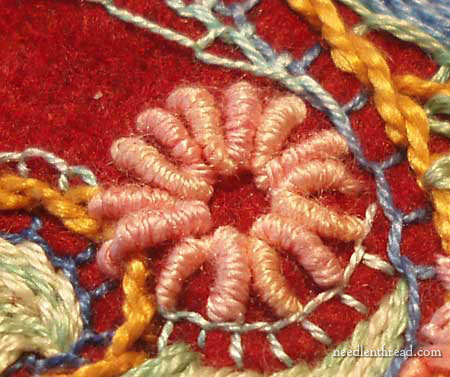
Just as in any art or craft, the right tools make the job of the embroiderer easier and more enjoyable. They also tend to result in better needlework. Needles are the essential tool of the embroiderer, so if you’re serious about enjoying your needlework, it’s worth taking the time to learn which kind of needle is used for which kind of embroidery.
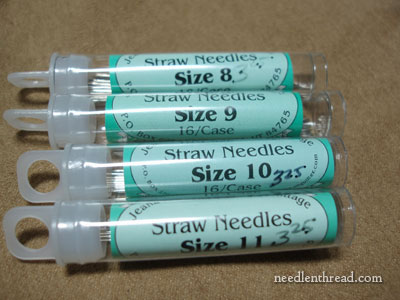
One day when I was out fabric shopping with my sister, I found myself face-to-face with a notions wall in a quilt shop, and – lo! – there on the wall were hanging many tubes of needles. I was delighted, thrilled, and just pleased to the core to find a variety of sizes of straw needles, which are also known as milliners.
Straw needles, or milliners, are the ideal tool for perfect, easy French knots and bullions. If you’re setting out to do a heap o’ French knots or bullions in any upcoming project, you’ve just got to make sure you have a supply of these needles on hand!
The advantage of the straw needle is its shape. Unlike most needles, the straw needle doesn’t bulge around the eye. The eye and the shaft of the needle are the same size all the way up. This means that, when you’re pulling the needle through wraps of thread, the needle is going to slip much more easily through the wraps, without the eye getting hung up.
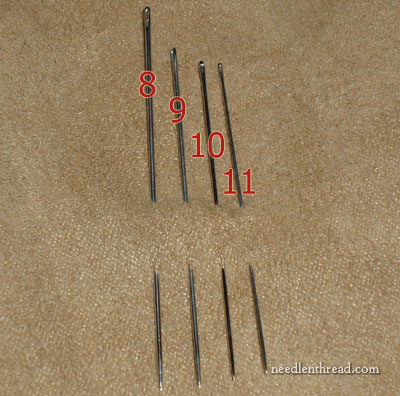
Straw needles are numbered just like embroidery needles – the lower the number, the larger the size. As you work from size 8 to size 11 here, you can see that the needles are becoming smaller.
For the needles above, the size 11 needle (the smallest) is still 1 1/2 inches long, which means it’s long enough to hold a good amount of wraps on it. The size 8 needle in the above line-up is 1 7/8 inches long, decidedly longer and ideal for long bullion knots with lots of wraps.
Straw needles are not limited simply to making French knots and bullions. They’re great for any stitch that requires the needle to pass through wrapped thread – for example, drizzle stitch and other cast-on stitches come to mind, and, as quilters know, they’re great for hand appliqué.
Where to Find Them
If you’re looking for milliner needles, I highly recommend Tulip’s milliners, which are available here. Tulip packages them as “milliner thick” (sizes 3, 5, and 7) and “milliner thin” (sizes 8, 9, and 10). If you’re looking for Very Large needles that can handle bullion knots and other cast-on stitches well, try Tulip’s “Bullion Needles.”
What’s your experience with embroidery needles? Do you use different needles for different tasks, or are you a One Needle Stitcher? Have you tried milliners or straw needles and found them useful, or do you find them unnecessary? Any hints or tips for good French knots and bullions? Share your thoughts below in the comments and let the rest of us know!


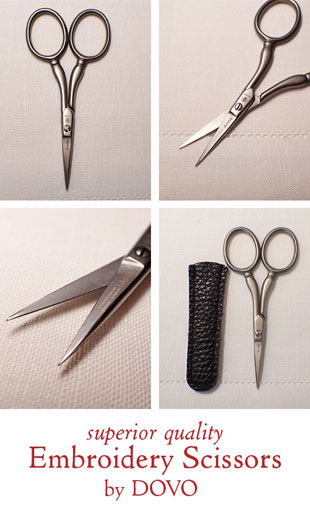
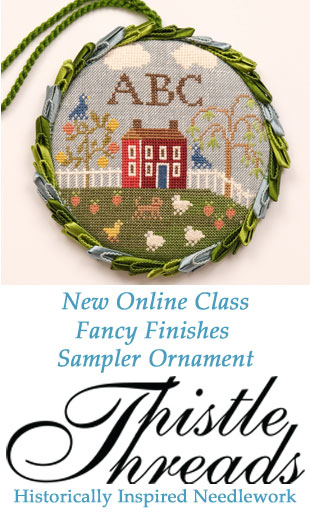
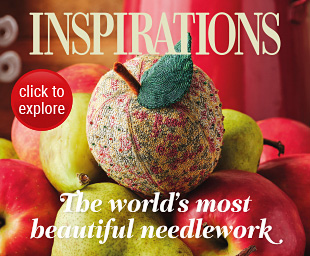


I used to have a gold needle for cross stitch. It made a huge difference, let me tell you. My fingers blacken a regular needle in hours. Sadly my ex took that and I’ve never found them again. I have to make do with the gold plate.
Different needles for different stitches make embroidery so much more fun! I have a little basket crammed full with different types of needles–and use them all. My basics are crewel and chenille but I also use tapestry, beading, betweens, embroidery, general sewing needles, doll maker’s needles (very long), leather, Japanese, sashiko, curved, and, of course, straw. I also have a collection of needles for use in ribbon embroidery (mainly chenille and embroidery) and a collection from Bohin. I also keep my eye out for needles at antiques shops–older needles (pre-1970s) are often much better than many new needles–the eyes are nice and smooth and don’t cut the thread (cheap needles will cut the thread and also be harder to thread–don’t buy cheap needles!) Even if they’re slightly tarnished, some emery helps. Emery will also polish up and sharpen your favorite needle. (With all the needles I have, if I lived in the 18th century, I’d be a very wealthy women. I feel like I have a treasure as it is!)
I was in fabric store yesterday pondering the needle display. This is timely post. Thanks much.
Oooh! I have been toying with the idea of a French-knot-heavy project, and I did not know about straw needles. I’m glad you posted this!
Thank you. I love French knots, but they don’t always love me. I will certainly keep an eye out for these needles! How easy are they to find? Do most “major” craft shops sell them, or do I need to go to someplace more specialist?
Oh, I did not know that. Thanks!
Hi Mary,
I agree 100% about the right needle making both of these stitches much easier! After your post on “The Right Embroidery Needle” I visited the Colonial Needle website and then found John James Needles online in England – cheaper shipping than from the US to Germany. I just love Pebble needle sets. Now I can do French knots beautifully and even got the courage to try bullions!
Yes, needles DO make a difference! The right size for the right fabric, thread, and stitch! I must say that fairly recent in my long stitching career I “discovered” Bohin needles and am smitten! They are really a pleasure to stitch with. So smooth – they just glide….. I also admit to buying “vintage” needles when I see them (and they aren’t rusted). Often the points seem “pointier” for some reason. And then, for course, all these needles need needlebooks, pincushions, emeries, and other assorted accoutrements! Hurray!
Love french knots and bullions !
I learned to make bullions with a straw needle since it was called for in the book/instructions that I was following. Though I must admit that at times I tend to be lazy and instead of switching needles I just used my embroidery/crewel needle to make them, which works fine if I do not make them to tight, I’m not in a hurry and is only a few bullions. In the event that a project calls for several bullions will definitely use a straw needle to get them looking more uniform and slide them off the needle easier.
For french knots I mostly use a regular embroidery/crewel needle, unless I’m “crowding” an area only with french knots.
Do agree that for learning these 2 stitches a straw needle will work the best.
Hi there Mary,
Well, you are right, there is only one needle for bullions as you said, it has to be milliners/straws.
I was thinking of you the other day, when I was completing bullion rose buds to attach buttons on a little bishop petticoat I was doing!
I do have a stash of needles and a little pamphlet which reminds me which ones for which job.
Last year I discovered gold needles ( not just gold eye) and managed to get a lady in the u.k. to both stock and send them to me. They do make a difference and I use them when I can.
Not always easy to get them in the different sizes…………..I have gold crewel needles for my smocking; they just glide through and are a joy to use.
Hello…just came across this informative site on needles and noted you mentioning buying gold needles. Is there a possibility to get an address, telephone number or email address so I could make contact to make purchases? Thanks much…from Vermont in USA
you are so generous with sharing your knowledge! i just love reading your posts..thanks so much!
Aha! I have been using straw needles for applique and love them. I started using them for embroidery and suddenly I could make French knots. I didn’t know my success was because of the change in needles. All I know is that I love straw needles for many fine sewing projects.
I love these needles! I discovered them when taking a hand applique class about 10 years ago and found they work wonderfully for that task. They are also very good for beading needles. When I thought I’d do more beading than I am, I went out and bought 10 packs of the size 11 needles – I’m still working through that splurge! I have all kinds of needles for my quilting and cross-stitch habits. Everything from the straws to quilting betweens. I love them all.
I didn`t realize the choice of needle would make such a huge differnce! I may even learn to like doing French knots…
What a great helpful hint. That’s where I always get hung up in french knots. This will come in handy when I start my Rooster project from your website! thank you so much, Kathy
Hi Mary you are right needles make a lot difference..usually I use pony needle number8 when using silk threads..for cone threads and rayon threads I use milliner needles..i really enjoy counting wraps around the needle for bullians or caston and fun pulling the needle with 40+ wraps….
I think I’m very close to being a needle junkie! I have almost every type of needle available in the US, but I would really like to find out where Marysia got the gold needles. I even have a couple of the Japanese embroidery needles available through Thistle Threads, but I haven’t tried them yet. I find that using the right needle not only makes the job easier, it makes the embroidery so much better. If you have every tried to make a bullion with a crewel then switch to a straw or sharp you’ll be amazed at the difference.
Yes I agree with everything you say about getting the right needle for the job. But I have found that you also have to watch the way you wrap your threads for bullions knots. Some threads require a clockwise wrap other and anticlockwise wrap depending on the twist of the thread.
Thanks for all the time and effort you put into this blog, it is appreciated.
Hi Mary,
I use Milliner’s needles for Bullions but am not fussy to change my needle for French Knots. Pony also makes Milliners needles but do not retail them in India.
G’day Mary,
I tend to get lazy (it’s a tiredness thing really) with watching what needle I use. “Oh this one will do” kind of thing, and just try to make the best of it. But, I am never really satisfied when that happens. Like, near enough is NOT good enough.
I have a good needle chart and try to do the right thing by it! The right needle definitely does make a big difference so it’s worth perservering with.
Chronic Fatigue and Fibromyalgia drain the brain (that’s my excuse anyway!) so I often can’t remember what needle I need/want to use for what stitches, even though I’ve used a particular one many times before, let alone sizes for different threads. So my needle chart is a tool in itself.
I always use a straw needle for Bullions though. Always. I’ve got that one sorted. I don’t remember for French Knots, but I do like doing them with whatever it is.
Thanks for a helpful post and glad of others comments too.
Cheers, Kath
I THINK (old memory) what I am using now for both embroidery and a quilting project is a milliners needle. The reason: I purchased a bunch of new needles a while back and got the different ones for particular tasks. I found that the milliner needle worked best with my hands which are not as nimble as they used to be. Being longer, if I drop one, it’s easier to find. The eyes are cranky also. The quilting project I’m working on was a favor for my great-nephew. One day he handed me his “binky” in tatters and asked if I could fix it. When he was about 3 he brought it to me and I repaired it. That section held but the rest of the quilt – was truly in tatters. I did everything right but it turned out all wrong so I’m still trudging along towards fixing it. It started out a baby gift, a tied quilt from baseball fabric. In addition to the tatters on one side, it had been tied with acrylic yarn. Everywhere the yarn was, there was a good size hole.
I backed the quilt fabric with a piece of flannel to stabilize it. Today, knowing what I know, I’d have used organza. Then came the batting – which I didn’t know could be split in half and of course, a good quality cotton for the backing. No way to skimp there.
On the top of the quilt to cover the tie holes, I found a flannel fabric covered with baseballs that blended into the original fabric. I cut out as many baseballs as I had holes (ALOT). I started out clipping and glue basting the balls onto the quilt. Eventually I learned how to needle turn them onto the quilt.
That was the easy part. Quilting the whole thing was another trial. I’m sure the quilt will hold up better with the flannel backing but between it and the batting the quilt is VERY thick. No cute quilting stitches here. Everything is stab stitch. Not having a real quilt frame I put the quilt in my largest round hoop (14 inches). I had worked on the quilt on and off for about 2 years. Two months ago I invested in one of those quilt stands that have a harp on top that holds a round hoop. The hoop is 18 inches. Transfered the quilt to it and am kicking myself for waiting so long to do this. What a difference. For a quilting template I traced off one of the baseball hats and they are placed all over the quilt.
The first big change that i did when I got my needle stash was to switch to the milliner needle. I had been using a regular quilting needle and this was by far easier to handle.
I have a little embroidery project – Christmas ornaments in redwork that I traced onto muslin. It is my grab-it project when I need to go somewhere. I switched needles to the milliner needle for it also. The thread is cotton floss and perle cotton and I find it very easy to manuever the needle around for the different stitches. They even look better because I am not fussing around trying to hold onto the needle. Pretty soon I’m going to be carrying around the last piece of the quilt. The “Big Patch.” It will have Jimmy’s name embroidered on it. With the new hoop, I should have it done in time for his birthday this year.
Brenda
Hi Mary,
I was a One Needle Stitcher before reading you 🙂 Then I found how different is to embroider with the right needle!
For long bullion knots: a while ago I was taught by an old Portuguese embroiderer a different way of making bullion knots – I’ve talked about here http://avomeri.wordpress.com/2010/03/06/ponto-canutilho-bullion-knot/
Oooh, how I have wished for milliner’s needles in the past after sitting and fighting with regular needles while making knots! (Hey, some of the knots I actually INTENDED to make..point to me, there!)
But never had a clue where to look for them, and I don’t think I’ve ever seen them in a store.
As usual, Mary, you are a godsend… 🙂
Milliner’s needles for bullions are a must for me. Before I ever made my first one, I was warned that the needle would make a huge difference, then “all” you had to think about was number of wraps, even tension, and keeping your thumb in the right spot.
DB – do you mean a solid gold needle? I wonder if a jeweler could help out, although I suspect it might be expensive.
I’ve only seen gold plated ones, and not tried those. Although based on comments here, I may need to. I think I’ve also seen platinum (?) needles, has anyone tried those?
Hello Mary. Thank you for the mention of our Staw needles in your posting about using the right needle for the right task.
I work primarily in hand applique. I learned years ago that the length of the Straw needle is ideal for all of my hand sewing. The length of this needle allows ample space for fingers to comfortably hold the needle while providing extra length to manipulate the fabric or the thread you may be working with. After more than 30 years of stitching hand work on a daily basis I have never had any discomfort or disablity with my hands and I attribute that to using a long needle.
Thanks for the endorsement.
Mary, was the quilt shop you were referring to in Kansas? I’m in need of several sizes of straw needles in the next couple of weeks and if the shop is close enough I may go there rather than ordering online. Thanks.
Hi, Janice – Yes, it’s in Lawrence. It’s called Sarah’s Fabrics. They sell mostly cotton fabrics – some really nice ones – but they have a wall of notions in the back, that have all kinds of needles on it. Across the street, there’s a stitchery / gift shop that has some stitching supplies in it, but mostly also sells quilting supplies and fabrics and books. Sarah’s is the larger of the two, and the one across the street from there doesn’t carry much in the way of notions, but they do have a lot of cross stitch stuff and primitive stitchery designs and so forth, as well as a small selection of specialty threads, and all the DMC threads.
Hope that helps!
MC
I knew about straw needles for bullions but never thought of using them for French knots…hmm…will have to give that a try because my French knots are never consistent. Thanks for the tip Mary!
Thanks, Mary. I’ve been in the Yarn Barn (or whatever it’s called) but for some reason have never made it into Sarah’s, so am glad to know about it.
Mary After I read your article. I odered some straw needles along with some other supplies. Thank you for the great ideas on making bullions and french knots.
I love your site so much I ‘brag’ about it in a few groups that I am in for stitching.
I am currently working on a needlebook just to organize out my needles per use. I am just starting to accumulate the needles needed per job description or task. Gets confusing at times but you have helped me un-confuse myself with your tips and tricks of knowledge…Thank you!
Sorry, this is a very late comment but I felt that this might help someone else who has trouble holding needles.
I have rather large hands for a lady and I find the straws are absolutely the best to work with. I find shorter needles are difficult to hold and continued use make my fingers ache. I would advise anyone who has this sort of problem to use Straws/Milliners needles.
I do have a collection of specialty needles and definitely used them when required. However, Straws are my workhorses and are used for the majority of my hand stitching needles. They are relatively easy to find in Australia and are a little more expensive than some but the quality and length of use is excellent.
I am currently working on a hand-sewn queen-sized quilt using 1″ (25mm) paper templates & my trusty Bohin Nº10 straw needles.
Thanks for the explanation of Milliners needles. I have a collection of needles from my Aunt who was a seamstress back in the day, born around 1908 to give you time frame. In the little box among many types of needles are Milliners, several sizes each wrapped in black paper. I thought they were just for her dressmaking. I cant wait to try them for French knots. Maybe that will help me improve doing them. After so many years they have always been the toughest for me to master.